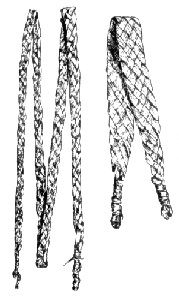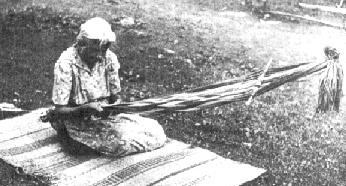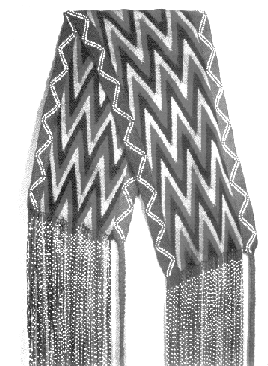
Man wearing finger woven sash, turban, and burden strap across his chest [1808], Huron/Canada (adapted from Sturtevant, gen. ed. 1978: p.391 "Handbook of North American Indians", Vol. 15 "Northeast").
 Man wearing finger woven sash, turban, and burden strap across his chest [1808], Huron/Canada (adapted from Sturtevant, gen. ed. 1978: p.391 "Handbook of North American Indians", Vol. 15 "Northeast"). |
|
 |
| Woven moose hide drag strap for toboggan and basswooda burden strap for carrying bundles [early 1900's], Penobscot/Maine (Canada (adapted from Speck 1976: p.74 "Penobscot Man"). |
Native Americans have developed unique techniques for weaving, an art with ancient origins. Finger weaving is a technique which evolved in many parts of the world, cultivated into a fine art by Native Americans. Native Americans of the eastern forests are well known for their finger woven yarn belts and sashes. Archaeological remains of pottery in the Northeast show where woven textiles were pressed into the clay some 3000 years ago. The constant wet environment of peat bogs in Florida have produced a piece of finger weaving 6,000 to 8,000 years old. Dry desert cave atmospheres of Arizona have preserved prehistoric finger woven examples of spun dog hair. South American Peruvians do finger weaving using a slightly different technique called Rep braiding. Other varieties of finger weaving are produced in European countries.
In northeastern North America, there is little pre-contact evidence that sophisticated looms were used. For bags and mats the simple suspension loom was used (where warp strands hang suspended with only one end secured). After contact with Europeans, Native Americans used a bow loom extensively in making wampum belts (where warp strings are stretched and fastened to either end of a bowed stick), but use of the loom was never as prevalent as in the western part of North America. Advancement of weaving beyond hand-held forms probably did not occur, at least with northern New England tribes such as the Penobscot, because birchbark was readily available and used to construct numerous kinds of containers and coverings.
A long tradition of finger weaving is obvious from the intricate examples which have survived from the time of European contact. Finger weaving techniques produced tumplines (burden straps for cradleboards, packs or other loads) and drag straps for sleds or toboggans, belts, sashes, garters or similar items of clothing, and even small bags. A 1672 comment in "New England Rarities" by Josselyn, an early European voyager, notes a burden strap used for a cradleboard: "...then putting the strap of leather upon their forehead with the infant hanging at their back home they trudge." Finger woven items measured from a few inches to more than five yards long.
Traditionally pre-contact materials for finger weaving included the inner bark of basswood, cedar and slippery elm trees, dogbane (Indian hemp) and milkweed fibers, nettle, wormseed and other plant fibers, as well as strips of moose hide. All woven the same way in different degrees of fineness depending on the intended function and the materials used. De Vries, a European explorer of New Netherland (New York), commented on the superior materials that Native Americans used in the early 1600's: "...and the savages use a kind of hemp, which they understand making up, much stronger than ours is, and for every purpose..."
In finger weaving, a number of lengths are tied to a secure post or tree. Keeping a steady tension, the dangling ends are tightly woven in an under-over pattern moving away from the fastened end. New lengths of basswood are spliced in as original lengths run out.
Penobscot prepare the inner bark of basswood by first cutting through the tree bark with an ax. The tree bark is loosened and pulled up in long strips. Using a knife the inner bark is loosened so it can be pulled off using the fingers in long strips. The long strips are rolled up into coils and carried home. The strips are then boiled with hardwood ashes, the layers are further separated with the help of a knife, and at last the fibers are softened by running the strips over a smooth hand stone. The lengths of basswood or other fibers were often dyed with plants or minerals one of several colors, commonly black, red-brown, yellow, or blue. Some Penobscot basswood finger weaving uses eight strips (less than one half inch wide) to make a well braided band only two and one half inches wide.
Traditionally finest finger-woven belts are decorated with false embroidery of dyed porcupine quills or moose hair, which was woven into the surface of one side of the belt. Embroidered designs are generally geometric, consisting of zig-zags, crosses, squares, and triangles. Zoomorphoic designs, animal beings like the Thunderbird, were embroidered on some belts.
Indigenous art industries of America were severely disrupted by European contact and trade. With European contact the Native Americans accepted and transformed many European techniques and materials into their existing traditions. Glass seed or pony beads (generally in white) were now woven into or sewn onto these belts. Often Native Americans unraveled yarn from new trade wool blankets, re-spun new string, and wove this into belts or garters that had diagonal, chevron, lightening and other designs.
French Canadian traders learned finger weaving from the Native Americans and began making what was later termed "Assomption" sashes from their originating town in Quebec. They became so popular their colors and designs became standardized and they were marketed through the Hudson's Bay and Northwest Trade Companies. These wide tightly-woven sashes were worn as belts, as straps for bags and powder horns, and even wrapped around the head turban-style. Although Europeans tried to replace the market with machine-made copies, the art of finger weaving has survived the centuries and continues to be made and worn by Native Americans of the eastern forests.

Woman making a large finger woven belt from wool yarn [mid 1900's], Chippewa/Great Lakes (Canada (adapted from Ritzenthaler and Ritzenthaler 1970: pl.32 "The Woodland Indians of the Western Great Lakes").

Woven hemp burden strap (tumpline) with dyed moose hair embroidery [1775-1800], Mohawk/Canada (Canada (adapted from Dockstader 1993: p.171 "Weaving Arts of the North American Indian").

Detail of finger woven wool yarn sash with lightening design and interwoven zig-zag beaded trim [1890-1910], Osage/Oklahoma (Canada (adapted from Dockstader 1993: pl.45 "Weaving Arts of the North American Indian").

Finger woven wool yarn sash with complex ceinture flech design [1890-1910], Osage/Oklahoma (Canada (adapted from Dockstader 1993: p.14 "Weaving Arts of the North American Indian").

© 1994-1999 Tara Prindle.